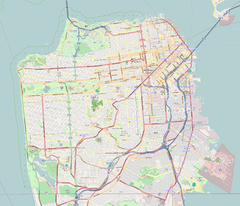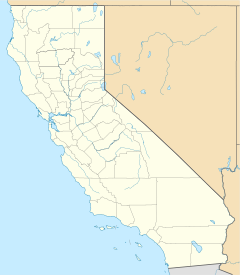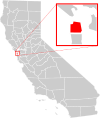Redstone Building
| The Redstone Building | |
|---|---|
 The San Francisco Labor Temple known today as the Redstone Building | |
| General information | |
| Status | Completed |
| Type | offices and community center |
| Location | 2926-48 16th Street San Francisco |
| Coordinates | 37°45′55.34″N 122°25′5.66″W / 37.7653722°N 122.4182389°W |
| Construction started | 1914 |
| Completed | 1915 |
| Opening | 1915 |
| Renovated | 1939 (addition) |
| Cost | USD $150,000 |
| Owner | David Luchessi |
| Technical details | |
| Structural system | Steel-reinforced brick facade |
| Floor count | 3 |
| Floor area | 50,000 square feet (4,600 m2) |
| Lifts/elevators | 1 |
| Design and construction | |
| Architect(s) | Matthew O'Brien |
| Main contractor | New Wing – Moore & Roberts |
| Designated | 2004[1] |
| Reference no. | 238 |
The Redstone Building, also known as the Redstone Labor Temple (and formerly called "The San Francisco Labor Temple"), was constructed and operated by the San Francisco Labor Council Hall Associates. Initial planning started in 1910, with most construction work done during 1914. Its primary tenant was the San Francisco Labor Council, including 22 labor union offices as well as meeting halls. The building was a hub of union organizing and work activities and a "primary center for the city's historic labor community for over half a century."[2]
The Redstone building played a significant role in the 1917 United Railroads Streetcar Strike[3] as well as the San Francisco maritime strike that led to the 1934 San Francisco General Strike.[4][5][6][7] The Redstone Building has been designated San Francisco's 238th landmark.[8]
The Redstone is located at 2940 16th Street between South Van Ness, formerly Howard Street, and Capp.
San Francisco Labor Temple

The San Francisco Labor Temple was dedicated on September 7, 1914, by former San Francisco mayor and head of the local Building Trades Council P.H. McCarthy. The cornerstone was set by A.J Gallagaher. The San Francisco Labor Council held a grand opening for the Labor Temple on February 27, 1915. The SF Labor Council newspaper, the Labor Clarion, described the building on the front page of its newspaper on February 26, 1915. The article described the building interior and gave details such as the $150,000 construction cost. The building included 22 office spaces, a number of large halls, and the 70-by-62-foot (21 by 19 m) main auditorium. The building would have its own medical and dental clinic. One of the first steel frame buildings erected in San Francisco,[9] the building is steel reinforced with a brick facade on two sides and masonry on the other. A new wing to the building was added in 1939 at a cost of $92,000.[citation needed]
Transition into a community center
On April 5, 1966, Dow Wilson, the secretary of the Brotherhood of Painters, Decorators and Paperhangers' San Francisco Local 4[10] was killed around the corner from the building in a corruption dispute.[11][12][13][14] His murder led to the building being sold to Peter Blasko for $228,000. The sale helped SFLC pay off their outstanding loan. They continued to lease space as did other unions after the murder of Wilson. Blasko later sold the property to the M.K Blake Estate which held the building until 1989. By this time the building had become a community center.[citation needed]
The Mission District, which used to be predominantly Irish and working class, had been shifting towards a predominantly Latino community. By the early 1980s the building would be leased to mostly Latino organizations with a couple labor organizations, American Federation of Teachers Local 2121 (until 1996), which represented teachers at San Francisco City College and AFSCME Local 1650.[15]
Theater Rhinoceros: 1981–2009
Theatre Rhinoceros or The Rhino, was established in 1977 to produce original LGBT[16] live theater to explore "the ordinary and extraordinary aspects of our queer community"[16] moved into the Redstone in 1981. The Rhino was the first gay theatre to receive funding from the National Endowment for the Arts[17] and is the "world’s oldest and longest-running queer theatre"[18] and was the Redstone's 2nd oldest and largest tenant[19] producing "an unparalleled amount of original work"[20] shown in The Rhino's two theaters. The Rhino's marquee and box office were at the Redstone's north entrance. After 5 years of major rent increases Rhino left the building on June 30, 2009.
Murals
The Clarion Alley Mural Project (CAMP), named after their first mural project on Clarion Alley (between 17th and 18th Streets near Mission Street) and The LAB announced the mural project to the tenants on April 19, 1996, after getting tentative support from the Redstone Building Manager. The LAB was awarded a grant from the Mayor's Office to cover artist fees and expenses for the mural project, and for the design and installation of a handicapped lift, to allow access to the entertainment venues The Lab and Theater Rhinoceros.
CAMP members spent several months researching the history of the building at San Francisco State University's Labor Archives. They followed this up with surveys to all of the Redstone Building tenants, followed by several meetings, including the first one with tenants on June 19, 1996. Working color sketches were supposed to be presented to tenants on September 3, 1996, but delayed until October 25, 1996. The sketches were then taken to the Building owner who gave permission to begin painting the murals. The initial phase of the CAMP project was made up of nine artists: Carolyn Castano, John Fadeff, Susan Greene (a Redstone tenant), Barry McGee, Ruby Neri, Sebastiani Pastor, Rigo '96, Lilly Rodriguez, Chuck Sperry and Project Director Aaron Noble. The project outreach coordinator was Mary Newson with the Lab's Laura Brun coordinating the administration of the city grant, which was part of the original $1.8 million Mission Armory Foundation money that was broken up by Mayor Brown and given to arts groups across the city.
On January 25, 1997, the Redstone Labor Temple Mural Project was dedicated by San Francisco mayor Willie L. Brown, Jr.[9]
The lobby and first floor of the Redstone's walls are covered by the CAMP murals, covering the building's labor, Filipino, Latino and gay history[21] that "reflect the building’s history and many uses"[9] and are "commemorating key labor actions like the (1934) strike and picket by the Chinese Garment Workers Union and the formation of the Bindery Women's Union."[22]
Six of the completed Red Stone Building murals depict the activities of the labor unions in the building (from 1914 to 1966). Chuck Sperry recreated the scene of a Labor Council planning meeting for the landmark 1934 General Strike, while Aaron Noble's piece illustrates two important moments in the city's labor history—when the corrupt union official Ben Rasnick was thrown out of the Red Stone Building by Dow Wilson; and, later, when Wilson was murdered by shotgun fire on April 5, 1966.
Other labor-themed murals in the building are Isis Rodriguez's illustration of the Bindery Women's Local 125, which occupied the building in the early 1920s; Sebastiana Pastor's depicting the organization of the Chinese Ladies Garment Workers Union Local 341 in 1938; Ruby Neri (with Alicia McCarthy)'s personal work (in ball-point pen) on the theme of sign painting—an oblique tribute to Sign Painters' Local 510, which sanctioned the project; and Susan Greene's rendering of the Service Employees International Union's hotel and department store strike of 1941.
The remaining six murals reflect later uses of the building. Two are historical: John Fadeff's piece evokes construction of the building's foundation, and Carolyn Castaño's depicts ballroom dancing in the former Filipino-American social club. Others reflect the building's current uses: an abstract piece by stencil artist Scott Williams for the entrance of the LAB, invoking a technological urban landscape; Barry McGee's illustration of immigrants floating to a new land; Rigo '97's "3/4 Water," celebrating the environmental organizations in the building; and Matt Day's small piece dedicated to the building's many alternative media organizations. Later, a mural honoring long-time building tenant Theater Rhinoceros was added to the project.
There is also a mural on the second-floor produced by the former Women's Luna Sea Theater Company.
The project was coordinated by the interdisciplinary artists group known as The LAB which produces art shows and events year round in the former labor temple's auditorium.
Redstone Tenants Association
The tenants of the Redstone started organizing and formed the Redstone Tenants Association (RTA) in 1999 to coordinate organizing around possibly buying the building and making general improvements to the large property as part of a general concern about gentrification of the neighborhood resulting in evictions and rising rents.[23] San Francisco was experiencing a hot rental market with the dot-com boom that created high-paying technical jobs and, in the process, displaced both commercial and residential renters with evictions and skyrocketing rents. With the help of the Mission Economic Development Association (MEDA) the tenants obtained a grant to do their own economic analysis of the building with the intent to make a formal bid for purchase. A variety of entities were approached with the hope of finding a non-profit owner.[citation needed] The Redstone Tenants Association is now known as the Redstone Labor Temple Association and has 501(c)(3) status.
San Francisco Designated Landmark
The first grant the RTA obtained was for $2,000 from the National Trust for Historic Preservation, which was used to start the process of obtaining historic landmark status for the building. The landmarking took from 2001 to 2004 to complete. The city formalized the building's historic status on July 14, 2004, assigning it number 238.[2] It is the second labor-related historic landmark in San Francisco. Exactly three years to the date of gaining historic landmark status, the annual "Labor Fest" did the first mural tour of the building and surrounding neighborhood.
On July 31, 2004, the Redstone celebrated the landmark status that had been bestowed by the San Francisco Board of Supervisors. The event included a proclamation from the Board as well as Walter Johnson, head of the SF Labor Council, who presented the plaque to the Redstone Building manager and Betty Traynor, RTA organizer. The event included musicians, poetry and historic information about the building, along with union members whose organizations once inhabited the former union hall.[24][25]
GLBT Historical Society
The Redstone Building was the location of the first public archives and office of the Gay and Lesbian Historical Society (now known as the GLBT Historical Society), an internationally recognized museum, archives and research center for gay, lesbian, bisexual and transgender history. Founded in 1985, the organization was housed in a private home until 1990, when it moved into a basement space in the Redstone Building.[26][27] After five years, the society moved out of the building and has subsequently been housed in larger spaces on Market Street and Mission Street in San Francisco.[26][27]
Unions
Unions |
|---|
Non-Union organizations
Artists and Arts Organizations
|
Twenty-first century
As of the year 1999, the current building had nearly 50,000 square feet (4,600 m2) of tenant space housing over forty tenants and four theaters, including Theatre Rhinoceros, the oldest gay theater in the U.S. and the Redstone's largest tenant.[19]
Today, its tenants include three theater ensembles: gay Theatre Rhinoceros, feminist Luna Sea, and the Latino El Teatro de la Esperanza. Other causes are evidenced by the groups' names: the Mission Area Federal Credit Union, the Filipino-American Employment and Training Center, the Industrial Workers of the World, the Homeless Children's Network, the Coalition on Homelessness, Hard Hat Magazine, the Eviction Defense Network, California Prison Focus, and on and on. "We call it a microcosm of the Mission and The City," said Elisabeth Beaird, the administrative director of The Lab, a visual and performance art gallery. "Almost every group is represented: Latino, activist causes, the arts, gays."[19]
See also
- 1934 West Coast Waterfront Strike
- Eight hour day
- Harry Bridges
- Labour Day
- Landrum-Griffin Act
- List of San Francisco Designated Landmarks
- List of Registered Historic Places in San Francisco, California
- Salting
- The LAB
- Strike
- Workers Memorial Day
References
- ^ "City of San Francisco Designated Landmarks". City of San Francisco. Archived from the original on 2014-03-25. Retrieved 2012-10-21.
- ^ a b "San Francisco Landmarks: Landmark 238". NoeHill. Retrieved 2007-08-01.
- ^ "United Railroads Streetcar Strike 1917". Shaping San Francisco. Archived from the original on 2007-07-13. Retrieved 2007-08-01.
- ^ Windborne, Jamie (July 16, 2007). "July Community Calendar". Mission Dispatch. Retrieved 2007-08-01.
- ^ "A Timeline of San Francisco History – 1900–1950". zpub.com. Archived from the original on 2019-04-19. Retrieved 2007-08-01.
- ^ "Police Battle Stevedore Mob, Arrest Many". San Francisco News reprinted by San Francisco Museum. July 3, 1934. Retrieved 2007-08-01.
- ^ Martí, Fernando (July 16, 2007). "Aquí Estamos y No Nos Vamos! 230 Years of Resistencia en la Misión". Comite de Vivienda San Pedro. Archived from the original on 2007-09-28. Retrieved 2007-08-01.
- ^ "San Francisco Landmarks list". San Francisco Preservation Society. 2003. Retrieved 2007-08-01.
- ^ a b c Noble, Aaron (10 June 2007). "Redstone Labor Temple Mural Project". Creative Work Fund. p. 13. Archived from the original on 2007-04-08. Retrieved 2007-08-01.
- ^ "Labor: Painters in Blood". TIME. 20 May 1966. Archived from the original on 30 September 2007.
- ^ "RavelLaw Search". Archived from the original on 2021-08-22. Retrieved 2021-08-22.
- ^ Benson, Herman. "Dow Wilson's Assassination: The Fight for Democracy in the Painters' Union". FoundSF.
- ^ "Simmonds v. People (1966)". FindLaw.
- ^ "Dow Wilson Assassination, 1965-1967". ArchivesSpace Public Interface.
- ^ "Redstone Labor Temple Tenants List". The Redstone Labor Temple Association.
- ^ a b "San Francisco Professional Queer Theater: About Rhino – History". Theatre Rhinoceros. July 2005. Retrieved 2007-08-05.
- ^ "2002 Grant Awards: Creativity – Theater". National Endowment for the Arts. 2002. Archived from the original on 2013-02-20. Retrieved 2007-08-05.
- ^ DeWitt, W. (August 2004). "More Queer This Year". Out Now. Archived from the original on March 7, 2005. Retrieved 2007-08-05.
- ^ a b c Costantinou, Marianne (November 29, 1999). "Specter of eviction in the Mission: Small businesses lose to dot-com gentrification". San Francisco Examiner. Retrieved 2007-08-01.
- ^ Adrian, Amber (Fall 2002). "25 Years of the Lavender Rhino". TheatreBayArea.org. Archived from the original on 2007-09-27. Retrieved 2007-08-05.
- ^ Mosher, Mike (October 1998). "Neighborhood Art Traffic Signals: Johanna Poethig's "Freeway Prophecy" Mural". Bad Subjects. Retrieved 2007-08-01.
- ^ Vogel, Richard D. (October 1998). "LaborFest 2007: A Moveable Feast". Monthly Review. Archived from the original on 2007-09-29. Retrieved 2007-08-01.
- ^ Kahn, Kelley (June 17, 2003). "A Tale of Three Cities, San Francisco, CA Focus on The Mission District". PBS. Retrieved 2007-08-01.
- ^ Mandelenis, Rita (June 29, 2004). "LaborFest 2004 Offers Films, Events Throughout July". El Tecolote. Archived from the original on September 27, 2007. Retrieved 2007-08-01.
- ^ "Architectural and Aesthetic Landmarks". City and County of San Francisco. Archived from the original on 2006-11-26. Retrieved 2007-08-01.
- ^ a b Wakimoto, Diana Kiyo (2012). Queer Community Archives in California Since 1950 (Brisbane, Australia: Queensland University of Technology; Ph.D. dissertation in information systems), chapter 5, "'There Really Is a Sense That This Is Our Space': The History of the GLBT Historical Society." Retrieved 2012-08-18.
- ^ a b GLBT Historical Society (2005-09-29). "GLBT Historical Society 20th anniversary gala" [program brochure] (San Francisco: GLBT Historical Society).
- ^ http://texts.cdlib.org:8088/xtf/data/13030/qm/tf4p3003qm/tf4p3003qm.xml[dead link]
Further reading
- Gray Brechin, Imperial San Francisco: Urban Power, Earthly Ruin, University of California Press, Berkeley, 1999.
- James Brook, Chris Carlsson and Nancy Peters, eds., Reclaiming San Francisco: History, Politics, Culture, City Lights Books, San Francisco, 198
- Manuel Castells, The City and the Grassroots: A Cross-cultural Theory of Urban Social Movements, University of California Press, Berkeley, 1983.
- Richard DeLeon, Left Coast City: Progressive Politics in San Francisco, 1975–1991, University Press of Kansas, 1992
- Antonio Díaz, “Race & Space: Dot-Colonization and Dislocation in La Misión,” in Shades of Power, 2000.
- Cassi Feldman, “Defending the Barrio,” San Francisco Bay Guardian, 2000.
- Brian Godfrey, Neighborhoods in Transition: The Making of San Francisco's Ethnic and Nonconformist Communities, University of California Press, Berkeley, 1988.
- Chester Hartman, City for Sale: The Transformation of San Francisco, University of California Press, Berkeley, 2002.
- Beatriz Johnston Hernandez, “The Invaders,” El Andar, 2000.
- Anthony Lee, Painting on the Left: Diego Rivera, Radical Politics, and San Francisco's Public Murals, University of California Press, Berkeley, 1999
- Mission Housing Development Corporation, A Plan for the Inner Mission, 1974.




